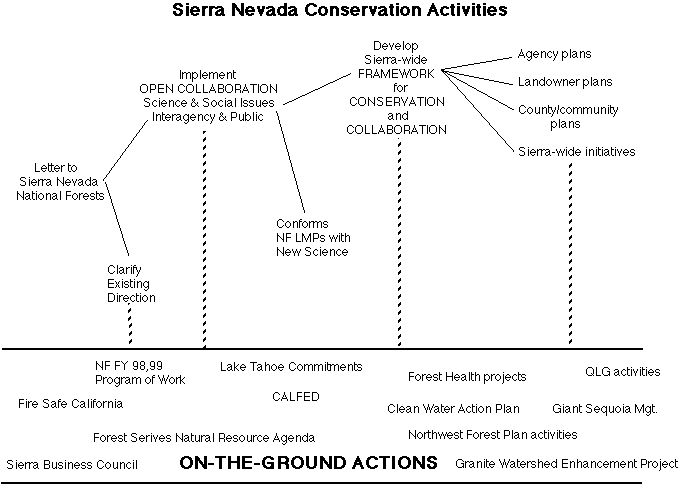| InBrief |
USDA Forest Service - Pacific Southwest Region
Conservation Activities In The Sierra Nevada
Interagency Activities
The California Biodiversity Council includes 37 state, federal and county agencies that coordinate efforts to conserve biological diversity and community vitality throughout California. To advance the goals and principles in the Council's Memorandum of Understanding on Biodiversity, USDA Forest Service Regional Forester Lynn Sprague and Pacific Southwest (PSW) Research Station Director Hal Salwasser have been talking with Council members and many others for several months about a “conservation framework" for the Sierra Nevada. The Forest Service initiated these cooperative discussions in response to new information provided by the Sierra Nevada Ecosystem Project (SNEP) report and the Forest Service's California spotted owl protection efforts.
The Sierra Nevada Conservation Framework should be considered a work-in-progress that may take several years to organize and implement. Most participants in the project are interested in a collaborative project in the Sierra. Some suggest that the framework address broad-scale, Sierra-wide issues. Others prefer to focus on coordination among on-going programs and projects. All agree on the need for a more open planning process on public lands and better coordination among local, state and federal government. These ideas are being explored by an interagency staff who will draft a charter for the framework. While the framework is being developed, Forest Service Region 5 and the PSW Research Station are moving ahead on critical resource issues on national forests in the Sierra Nevada.
National Forest Activities
Helping Keep the Options Open
As responsible land stewards, the Forest Service must
make timely and appropriate use of new scientific information. In
a May 1, 1998 letter, the Regional Forester clarified existing
guidelines and identified relevant new information for forest
supervisors to consider when planning management activities in
the Sierra Nevada. This action is part of the Forest Service
commitment to ensuring that activities on national forests do not
preclude future options for protecting and conserving healthy
ecosystems in the Sierra Nevada. The letter also starts the
process of incorporating recent science into national forest
management.
Science-based assessments
A great deal of valuable new science has evolved since
the Forest Service issued interim guidelines for the protection
of California spotted owl (CASPO) in 1993. PSW Research Station
scientists, with
assistance and review by scientists and resource specialists from agencies and universities, will sort through the recent scientific information and identify information relevant to national forest management in the Sierra. Of particular interest will be new science related to older forest habitats (including habitats for spotted owls, marten, fisher and old-growth trees), riparian and aquatic habitats, fuel loading and risk of wildfire. Their work will help distill relevant issues from existing work such as the Sierra Nevada Ecosystem Project and related recent scientific thinking on Sierra ecosystems. This work will finish by mid-summer and will be considered by the Regional Forester when he determines an appropriate process for incorporating new information into national forest management.
Collaboration and Open Process
The Forest Service is committed to working with tribes,
communities, scientists, resource specialists and interest groups
in a more open, collaborative way We're convinced that
collaboration will help to better define issues and concerns in
the Sierra and will lead to more effective improvements in
ecosystem health. Our work must be more open, visible and
available for public review
We are beginning discussions among a wide range of people interested in the Sierra. Hearing people's views on the important scientific issues and social concerns for the Sierra will help Forest Service efforts and the interagency framework. We want to hear which issues people feel are relevant to only national forest lands and which relate to the larger landscape, across all ownerships. We want to encourage dialog among interest groups and to gather ideas on various approaches for managing Sierra Nevada ecosystems. We're especially interested in hearing people's expectations for national forest lands in the coming decades.
Discussions with interested people will help us evaluate how to adjust existing land management plans on the national forests in the Sierra Nevada. While the initial "push" for better collaboration is in the coming months, open process and collaboration really must become a continuing part our work.
Updating Forest Service Plans
After carefully considering the science assessments and the ideas
generated from discussions with public and interest groups, the
Regional Forester will decide on an appropriate process to
incorporate new science and public expectations into land
management plans. By mid-summer, we expect to begin this process,
using National Environmental Policy Act procedures. It will take
12-18 months to complete.
Commitments
Underlying all these activities is the Forest Service commitment
to conserve ecosystem health in the Sierra Nevada and our
commitment to work more effectively with tribes, communities,
agencies and others with an interest in improving the health of
Sierra ecosystems and communities.
These activities must be well coordinated with other on-going activities in the Sierra. To give an idea of how these interrelated activities may fit together there is a diagram on the following page.
For Additional Information:
For more information, or to share your ideas with us, please contact the Forest Supervisor at the national forest nearest you. In addition, you may contact the following people who are working with the Regional Forester and the Station Director on these activities:
Rick Alexander 415 705-1837, Public Affairs and Communications
Mike Chapel 530 478-6203, Sierra Nevada Conservation Framework
Kathy Clement 415 705-1834, Forest Service Planning
David Diaz 415 705-1891, Ecosystem Conservation
Connie Millar, 510 559-6435, PSW Research Station Science
Assessments

| sncpm6.5 | May 8, 1998 |
Sunday, January ,(, /),( 0(:,(:,( AM